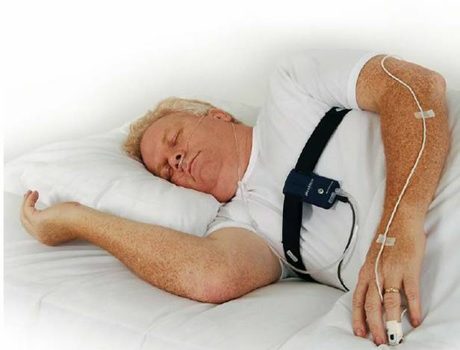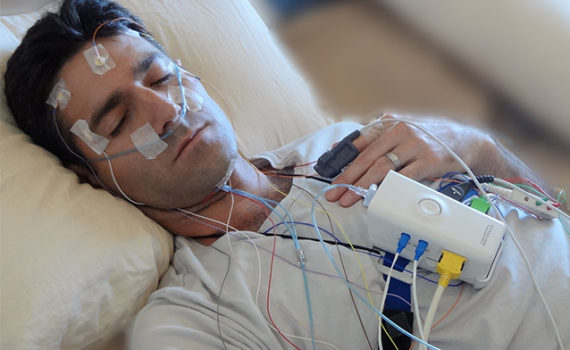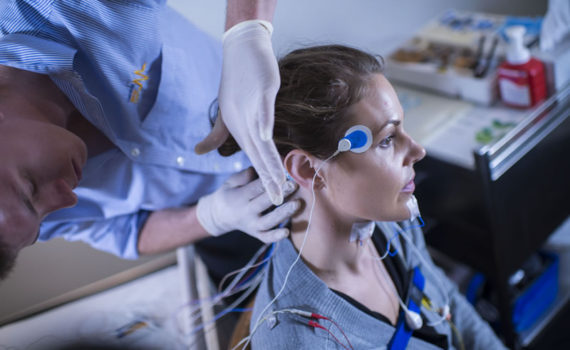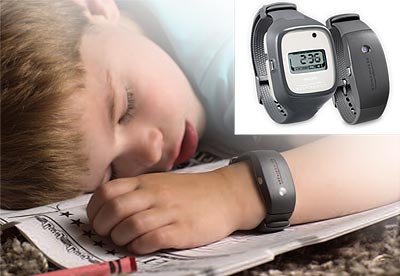To study your sleep, we need to monitor and observe some of the physiological changes during sleep. A Home sleep test or polysomnogram can help to discover the causes of sleep disorders and plan your treatment. We do the sleep study during your normal sleeping hours
Finally, home sleep test may be used occasionally in individuals who are unable to have a diagnostic polysomnogram in a center due to immobility, safety, critical illness, or other conflicts. Importantly, home sleep test is not appropriate for children

First of all, sleep test or Polysomnography (PSG) is an overnight sleep study in the sleep center. Following your visit, your sleep doctor will order a sleep test to determine if you are experiencing sleep disease. The test is a simple, painless procedure that will take place overnight in a sleep lab.
On the night of your sleep study, you’ll be will have your own private bedroom in a sleep center. Furthermore, near the bedroom we have the monitoring area, where technicians watch and check on you while you sleep.
When you are ready to go to bed, a trained sleep technician will prepare you for the test and apply the sensors. We place the sensors on your scalp, forehead, chin, chest, leg, and index finger to collect information from your brain, heart, lungs, and muscles. Even more, we wrap bands around your chest and stomach to measure your breathing. Most noteworthy, patients fall asleep and stay asleep without trouble. Even more, none of these devices hurt.
Finally, when it is time for you to try to go to sleep, the lights will go off and a low-light video camera will allow the technologist to see you from a nearby room. First of all, at the start of the test, you will be asked to move your eyes, clench your teeth and move your legs. This will make sure that the sensors are working. The sleep technician will monitor the physiological indicators during sleep including brain waves, heart rate, breathing rate, oxygen level, eye movements, and chin movements. Furthermore, if a sensor comes loose or you need to go to the bathroom during the night, the technologist will have to help you with the wires.
Nearly everyone falls asleep during an in-lab study. In most cases, you do not need a full eight hours of sleep for the doctor to make a diagnosis.
On the day of your in-lab sleep study, you should:
Try to follow your regular routine as much as possible.
Avoid napping.
Eliminate use of caffeine after lunch.
Shower or avoid using hair sprays or gels that can interfere with the sleep recording.
If you are on a regular medication, speak with your sleep medicine physician.
Bring any items that you need for your nightly routine. Prepare for the sleep study as if you are staying at a hotel for a night. You may want to bring: comfortable pajamas or clothes to sleep in, a toothbrush, toothpaste, and dental floss.
Certainly, if you have a spouse or partner, they will not be allowed to stay with you overnight.

The sleep technician will remove the monitoring devises. Within few days you have to come to sleep Disorders Clinic for your follow up appointment with your Physician.
You likely will not be given any information about your study until a sleep doctor has had a chance to review the results. This probably will take some time. Sleep study reports can be as many as five pages long and packed with hundreds of pieces of data about everything from the stages of sleep you went through and your breathing, heart rate, oxygen levels, muscle movements, episodes of snoring, and more.
Finally, Your Physician will explain the test results to you and he will discuss with you the treatment.
For those with excessive daytime sleepiness, multiple sleep latency testing (MSLT) may follow a diagnostic polysomnogram.
Do you know about 50 percent of adults experience occasional insomnia, and one in 10 suffers from chronic insomnia? It is twice as common in women as men, and is more common in older than younger people
Patients, who suffer from insomnia, wake up from sleep and remain inactive, and tired, which affects their performance during the day, the level of energy, mood, health, quality of work, and quality of life.
Avoid taking a nap in the late afternoon or evening. If you nap, try to have it in early afternoon and shall not exceed a period 30 minutes. Avoid the stimulants caffeine, cola, and chocolate. Also, avoid smoking before bedtime. Do not eat large heavy meals or excessive drinking fluids before bedtime. When it is time to sleep, close the phone and do not think about any personal or family problems.
Sleep apnea test can determine if you are experiencing sleep apnea.
Furthermore, the sleep apnea test is a simple, painless procedure that will take place overnight in a sleep lab or in your home, depending on your health history.

Multiple Sleep Latency Test (MSLT) measure how quickly you fall asleep in a quiet environment during the day. Similarly, also known as a daytime nap study.
The Multiple Sleep Latency Test (MSLT) is the standard tool used to diagnose narcolepsy and idiopathic hypersomnia.
First of all, the night before your MSLT, you get overnight sleep study. This is because for the MSLT to be accurate, you will need to sleep at least six hours during the overnight sleep study. An overnight sleep study can determine if another sleep disorder such as obstructive sleep apnea is causing your excessive daytime sleepiness. There is also a video and audio recording that provides a record of the night’s sleep.
After waking up, you will have scheduled naps at two-hour intervals throughout the day. These consist of 20-minute periods where you will go to bed and try to fall asleep. Certainly, the sleep technician monitors you to see when you fall asleep. Various physiological parameters are monitored while you sleep. including an EEG, EKG, breathing, oxygen levels, muscle tone, and eye and extremity movements.
After 20 minutes, the sleep technician will stop the recording and wake up the patient if he sleeps. Similarly, this process is repeated every two hours up to 5 naps trial.
Almost, the first nap starts an hour-and-a-half to three hours after you wake up from the overnight sleep study.
One of the primary measures of MSLT is sleep latency, or how long it takes you to fall asleep. The premise is that people with excessive daytime sleepiness will fall asleep more quickly, and thus this testing should reveal this phenomenon. There is a wide range of normal sleep latencies, and a short one may not necessarily suggest a sleep disorder. As with any sleep testing, it is important to undertake the tests for the right reason and any results must be understood in the proper clinical context.

MWT can measure how alert you are during the day. It shows whether you are able to stay awake for a defined period. This is an indicator of how well you are able to function and remain alert in quiet times of inactivity.
The test measures your ability to stay awake in day time in quiet bedroom. It is also used to help judge whether a patient is too tired to drive or perform other daily tasks.
MWT consists of four sleep trials with breaks lasting for two hours in between them. For each trial, you will sit quietly in bed with your back and head supported by a pillow. It is important that you are as comfortable as you can be. You need to sit still and look directly ahead of you. Then you simply try to stay awake for as long as you can. You can not do other things to try to keep yourself awake. This includes actions such as singing or slapping your face. All sunlight will be kept out of your room.
If you fall asleep for at least 90 seconds, then you will wake you up. The test will end if you do not fall asleep within 40 minutes.
In individuals who have excessive daytime sleepiness, the maintenance of wakefulness test (MWT) may be a useful diagnostic test to identify an inability to stay awake.

It is now possible to measure a person’s activity, environmental temperature, and light levels, all by a device like a wristwatch. We use Actigraphy in the assessment of patients with Insomnia Circadian Rhythm Disorders or other sleep disorder.
It is now possible to measure a person’s activity, environmental temperature, and light levels, all by a device like a wristwatch. We use Actigraphy in the assessment of patients with Insomnia Circadian Rhythm Disorders or other sleep disorder.
Sleep test at home can collect information about your sleep to diagnose obstructive sleep apnea . While polysomnography is sleep test in the medical facility under direct supervision of sleep specialist.
If the patient has a chance that he has moderate to severe sleep apnea then his sleep doctor will order a sleep test at home.
After ordering the sleep test, you will meet a technologist to learn how to setup and use the device. The portable sleep monitor is easy to activate. It includes a recording device, sensors and belts and is powered by AA batteries. Its records information, including your airflow, breathing effort, blood oxygen levels and snoring during your sleep. You will have the opportunity to practice applying the device with one of our sleep technologists so you are more comfortable using the equipment on your own. You will return the monitor the day after your study and the results will be sent to your referring physician within a week.
Therefore, in summary, first, the patient will take a simple sleep monitor equipment from the center. When you are ready to sleep, you will attach the sensors to your body as instructed. When you wake up in the morning, you can remove the sensors. Finally, take the device back to the sleep center.
There is a variety of home sleep apnea testing devices.
The Benefits and Drawbacks of Home Sleep Testing
There are a number of reasons that patients prefer to have a home sleep test, including:
It is typically less expensive, costing hundreds of dollars compared to the thousands of dollars an in-center test may cost.
and more convenient, allowing you to sleep at home rather than in an unfamiliar environment.
It is more comfortable, with fewer wires and access to the comforts of home.
There is more access to the testing. Sleep centers may not be accessible due to location or even scheduling. Home testing devices can be sent home from the doctor’s office and are sometimes even mailed out.
The gold standard for the diagnosis of all sleep disorders remains the attended diagnostic polysomnogram in a sleep center.
First, take this Sleep Quiz to evaluate your risk of having Sleep Apnea: Are you a loud, habitual snorer? Has your partner ever witnessed you choking, gasping or holding your breath during sleep? Do you regularly feel un-refreshed in the morning or with morning headache even after waking up from a full night‘s sleep? Do you fall asleep easily in day time while reading, watching TV, or driving? Have you suffered poor concentration or attention, memory loss, irritability, or bad mood? Do you have high blood pressure or obesity?
For this Quiz, if you answer yes for two or more questions, you may be at risk of Sleep Apnea or other sleep disorder. However, take the results to your doctor to discuss further.
Similarly, take this Sleep quiz to evaluate your risk of having jet lag when traveling :-Disturbed sleep — such as insomnia, early waking or excessive sleepiness? Daytime fatigue? Difficulty concentrating or functioning at your usual level? Stomach problems, constipation or diarrhea? A general feeling of not being well?
Mood changes?
For this Quiz, if you answer yes for two or more questions, you may be at risk of recurrence of Jet Lag when traveling in airplane.
Does your teen show any of these abnormal Sleep Disorder signs?
Has trouble waking up most mornings?
Acts irritable in the early afternoon?
Falls asleep easily during the day?
Maybe has a drop in grades?
Sleeps for very long periods on the weekends?
For this Quiz, if you answer yes for two or more questions, you may be at risk of Sleep Apnea or other sleep disorder. However, take the results to your doctor to discuss further.